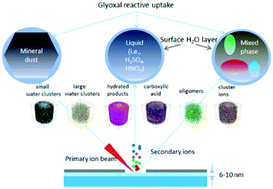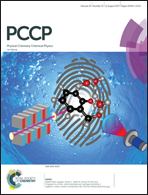Deciphering the aqueous chemistry of glyoxal oxidation with hydrogen peroxide using molecular imaging†
Abstract
Aqueous surfaces after photochemical and dark reactions of glyoxal and hydrogen peroxide (H2O2) have been studied using a microfluidic reactor coupled with an in situ liquid time-of-flight secondary ion mass spectrometry (ToF-SIMS) for the first time. Spectral principal component analysis was used to determine similarities and differences among various photochemical aging and dark reaction samples and controls. Compared with previous results using bulk solutions, our unique liquid surface molecular imaging approach provided observations of glyoxal hydration (i.e., first and secondary products), oxidation products (i.e., glyoxylic acid, oxalic acid, formic acid, tartaric acid), oligomers, cluster ions, and water clusters with sub-micrometer spatial resolution. Observations of oxidation products give the physical foundation to deduce new reaction pathways at the aqueous surface. The first chemical mapping of water cluster changes between dark and photochemical aging suggests that glyoxal oxidation affects the hydrophobicity and water microenvironment at the surface, influencing the particle's ability of reactive uptake and subsequent cloud condensation nucleation and/or ice nucleation activation. Moreover, SIMS three-dimensional chemical mapping has made it possible to visualize the surface mixing state for the first time. We potentially provide a new method to investigate complex surface chemistry as an important source of aqueous secondary organic aerosol (aqSOA) formation in atmospheric chemistry.

- This article is part of the themed collection: 2017 PCCP HOT Articles


 Please wait while we load your content...
Please wait while we load your content...